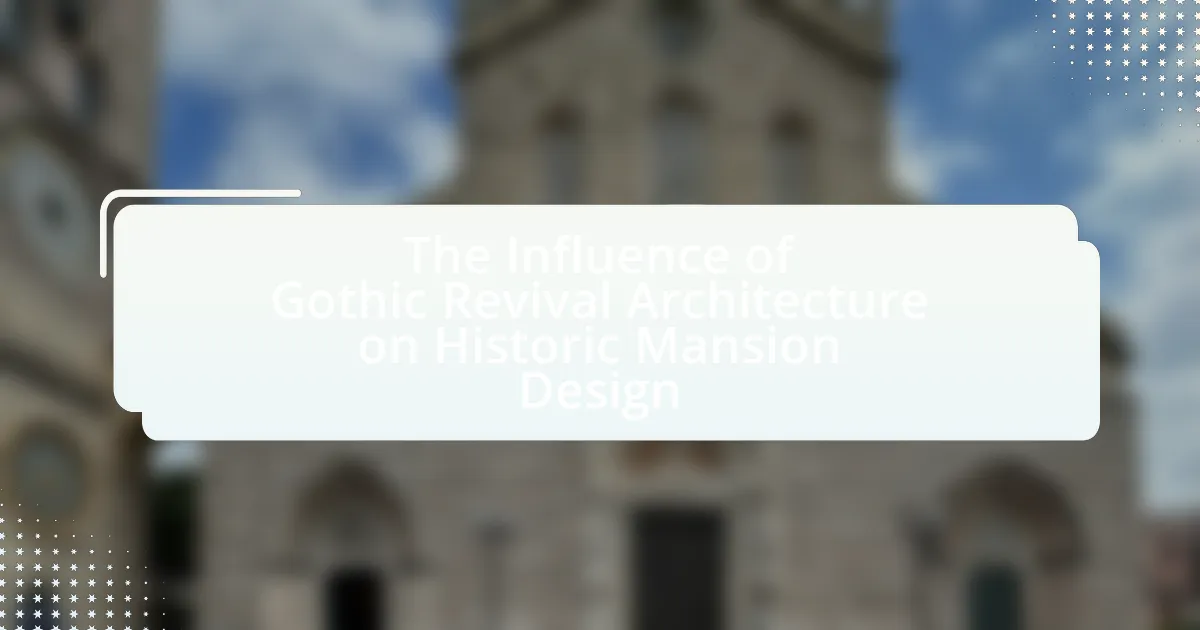Gothic Revival Architecture is a significant architectural style that emerged in the late 18th century and gained prominence in the 19th century, characterized by medieval elements such as pointed arches and ribbed vaults. This article explores the emergence of Gothic Revival, its historical influences, and key characteristics, highlighting its impact on the design of historic mansions. Notable examples, such as the Lyndhurst Mansion and the Houses of Parliament, illustrate how this style reflects the cultural values of its time and has shaped architectural practices. The discussion also includes the preservation of Gothic Revival mansions and lessons for modern architects in incorporating these elements into contemporary designs.

What is the Gothic Revival Architecture?
Gothic Revival Architecture is a style that emerged in the late 18th century and became prominent in the 19th century, characterized by its use of medieval Gothic elements such as pointed arches, ribbed vaults, and flying buttresses. This architectural movement sought to revive the aesthetics of the Gothic period, particularly in ecclesiastical and collegiate buildings, as seen in structures like the Houses of Parliament in London, designed by Charles Barry and Augustus Pugin. The style reflects a romanticized view of the Middle Ages and was often employed to convey moral and spiritual values, making it significant in the context of historic mansion design during its peak.
How did Gothic Revival Architecture emerge?
Gothic Revival Architecture emerged in the late 18th century as a reaction against the neoclassical style, emphasizing medieval Gothic elements. This architectural movement gained momentum in the early 19th century, particularly in Britain and the United States, driven by a growing interest in the romanticism of the Middle Ages and a desire for national identity. Key figures, such as Augustus Pugin and Eugène Viollet-le-Duc, played significant roles in promoting Gothic Revival principles, advocating for the use of pointed arches, ribbed vaults, and intricate ornamentation. The movement was further fueled by the publication of influential works, such as Pugin’s “Contrasts” in 1836, which illustrated the moral and aesthetic superiority of Gothic design over classical forms.
What historical influences shaped Gothic Revival Architecture?
Gothic Revival Architecture was primarily shaped by the Romantic movement, which emphasized emotion and individualism, as well as a renewed interest in medieval art and architecture. This architectural style drew inspiration from the Gothic cathedrals of the Middle Ages, particularly in England and France, where structures like the Westminster Abbey and Notre-Dame Cathedral exemplified the intricate details and verticality characteristic of Gothic design. The movement gained momentum in the 19th century, fueled by the writings of figures such as Augustus Pugin, who advocated for the moral and aesthetic superiority of Gothic architecture. Additionally, the Industrial Revolution played a role by providing new materials and construction techniques, allowing for the revival of complex Gothic forms in residential and public buildings.
What are the key characteristics of Gothic Revival Architecture?
Gothic Revival Architecture is characterized by its pointed arches, intricate detailing, and vertical emphasis. This architectural style, which emerged in the late 18th century and gained popularity in the 19th century, often features elements such as ribbed vaults, flying buttresses, and ornate tracery. Notable examples include the Houses of Parliament in London and St. Patrick’s Cathedral in New York City, which showcase these defining traits. The revival was influenced by medieval Gothic architecture, aiming to evoke a sense of grandeur and spirituality, as seen in its use of stained glass windows and elaborate stone carvings.
Why is Gothic Revival Architecture significant in design history?
Gothic Revival Architecture is significant in design history because it marked a revival of medieval Gothic styles, emphasizing verticality, intricate detailing, and a connection to spirituality. This architectural movement, which gained prominence in the 19th century, influenced the design of numerous historic mansions, showcasing features such as pointed arches, ribbed vaults, and flying buttresses. The significance is further underscored by landmark examples like the Palace of Westminster in London, completed in 1876, which exemplifies the style’s grandeur and complexity, reflecting societal values of the time and a reaction against industrialization.
How did it reflect the cultural and social values of its time?
Gothic Revival architecture reflected the cultural and social values of its time by emphasizing romanticism, individualism, and a connection to nature. This architectural style emerged in the 19th century, during a period marked by a reaction against industrialization and a desire to revive medieval aesthetics, which were seen as more authentic and spiritually enriching. The intricate designs, pointed arches, and elaborate ornamentation of Gothic Revival buildings symbolized a longing for a past that was perceived as more noble and connected to community values. Additionally, the use of local materials and craftsmanship in these structures highlighted a growing appreciation for regional identity and sustainability, aligning with the era’s social movements advocating for a return to traditional craftsmanship and community-oriented living.
What impact did it have on architectural practices?
The Gothic Revival architecture significantly impacted architectural practices by reintroducing medieval design elements and emphasizing verticality, intricate detailing, and the use of pointed arches. This movement, which gained momentum in the 19th century, influenced the design of historic mansions by encouraging the incorporation of features such as elaborate facades, stained glass windows, and ornate woodwork. The popularity of Gothic Revival can be evidenced by the construction of notable buildings like the Houses of Parliament in London, designed by Charles Barry and Augustus Pugin, which showcased these characteristics and inspired similar designs across Europe and America.

How has Gothic Revival Architecture influenced Historic Mansion Design?
Gothic Revival Architecture has significantly influenced Historic Mansion Design by introducing elements such as pointed arches, intricate detailing, and asymmetrical facades. These features became prominent in the design of mansions during the 19th century, reflecting a romanticized interpretation of medieval architecture. For instance, the use of decorative stonework and elaborate gables in mansions like the Lyndhurst Mansion in New York exemplifies this influence. Additionally, the emphasis on verticality and ornate interiors in Gothic Revival designs contributed to the grandeur and aesthetic appeal of historic mansions, making them symbols of wealth and status during that era.
What are the defining features of mansions influenced by Gothic Revival?
Mansions influenced by Gothic Revival are characterized by pointed arches, intricate detailing, and asymmetrical designs. These features reflect the architectural style’s emphasis on verticality and ornate craftsmanship, often incorporating elements such as steeply pitched roofs, elaborate stonework, and decorative tracery. The use of materials like brick and stone, along with features such as gargoyles and finials, further exemplifies the Gothic Revival’s aesthetic. Historical examples, such as the design of the Smithsonian Castle in Washington, D.C., showcase these defining characteristics, illustrating the movement’s impact on mansion architecture during the 19th century.
How do these features differ from other architectural styles?
Gothic Revival architecture features distinct elements such as pointed arches, intricate tracery, and verticality, which set it apart from other architectural styles like Neoclassicism or Modernism. Unlike Neoclassicism, which emphasizes symmetry and classical forms, Gothic Revival focuses on ornate details and a sense of height, creating a dramatic visual impact. Additionally, while Modernism prioritizes minimalism and functionalism, Gothic Revival embraces decorative complexity and historical references, evident in its use of materials like stone and stained glass. These differences highlight the unique aesthetic and cultural values embodied in Gothic Revival architecture compared to its contemporaries.
What materials are commonly used in Gothic Revival mansions?
Gothic Revival mansions commonly utilize materials such as stone, brick, and wood. Stone, particularly limestone and granite, is often employed for its durability and aesthetic appeal, while brick is used for structural elements and decorative features. Wood is frequently incorporated in intricate detailing, such as carvings and moldings, reflecting the craftsmanship of the period. These materials not only contribute to the distinctive architectural style but also enhance the overall grandeur and historical significance of Gothic Revival structures.
Why did architects choose Gothic Revival elements for mansion design?
Architects chose Gothic Revival elements for mansion design primarily to evoke a sense of grandeur and historical significance. This architectural style, which emerged in the 19th century, was characterized by features such as pointed arches, intricate detailing, and verticality, which collectively created an imposing and romantic aesthetic. The revival was influenced by the medieval Gothic architecture, appealing to the Victorian era’s fascination with the past and its ideals of craftsmanship and artistry. Notably, the use of these elements in mansions symbolized wealth and status, as seen in prominent examples like the Houses of Parliament in London, designed by Charles Barry and Augustus Pugin, which showcased the style’s capacity to convey power and cultural heritage.
What aesthetic qualities do these elements bring to mansion design?
Gothic Revival architecture brings intricate detailing, verticality, and a sense of grandeur to mansion design. These aesthetic qualities manifest through features such as pointed arches, elaborate stone carvings, and steeply pitched roofs, which create a dramatic visual impact. The use of stained glass windows enhances the interior ambiance with colorful light, while ornate gables and finials contribute to the overall elegance. Historical examples, such as the design of the Houses of Parliament in London, illustrate how these elements can evoke a sense of history and sophistication, reinforcing the aesthetic appeal of mansions influenced by this architectural style.
How do these choices reflect the identity of the era?
The choices in Gothic Revival architecture reflect the identity of the era by emphasizing a return to medieval aesthetics and values, which resonated with the 19th-century fascination for romanticism and nationalism. This architectural style, characterized by pointed arches, intricate detailing, and verticality, symbolized a cultural shift towards embracing historical styles as a reaction against industrialization and urbanization. For instance, the construction of mansions like the Lyndhurst in New York showcases these elements, illustrating how the era’s elite sought to connect with a perceived noble past while asserting their social status. The revival of these architectural choices served not only as a visual representation of the era’s ideals but also as a means of expressing cultural identity and heritage during a time of significant societal change.

What are some notable examples of Gothic Revival mansions?
Notable examples of Gothic Revival mansions include the Lyndhurst mansion in Tarrytown, New York, and the Gothic Revival-style Castle Ward in County Down, Northern Ireland. Lyndhurst, designed by architect Alexander Jackson Davis, showcases intricate detailing and picturesque landscaping, completed in 1865. Castle Ward, built in the 18th century, features a unique blend of Gothic and classical styles, reflecting the architectural trends of its time. These mansions exemplify the characteristics of the Gothic Revival movement, such as pointed arches, elaborate ornamentation, and a romanticized medieval aesthetic.
Which mansions are considered iconic representations of this style?
Iconic representations of Gothic Revival architecture include the Lyndhurst Mansion in Tarrytown, New York, and the Gothic Revival-style Castle Hill in Ipswich, Massachusetts. Lyndhurst, designed by architect Alexander Jackson Davis, showcases characteristic elements such as pointed arches and intricate detailing, completed in 1865. Castle Hill, designed by architect Richard Morris Hunt, features similar Gothic elements and was built in the late 19th century. Both mansions exemplify the style’s emphasis on verticality and ornate decoration, solidifying their status as key examples of Gothic Revival architecture in historic mansion design.
What unique features do these mansions exhibit?
These mansions exhibit unique features such as pointed arches, intricate stone carvings, and asymmetrical facades, which are hallmarks of Gothic Revival architecture. The pointed arches allow for taller ceilings and larger windows, enhancing natural light and creating a sense of grandeur. Intricate stone carvings often depict historical or mythical figures, adding artistic value and storytelling elements to the structure. Asymmetrical facades contribute to a more organic and less rigid appearance, reflecting the romantic ideals of the Gothic Revival movement. These architectural elements not only define the aesthetic of the mansions but also connect them to the historical context of the Gothic Revival, which sought to revive medieval architectural styles in the 19th century.
How have these mansions been preserved or restored over time?
Mansions influenced by Gothic Revival architecture have been preserved and restored through a combination of careful maintenance, historical accuracy in renovations, and the establishment of preservation societies. These efforts often involve using original materials and techniques to maintain architectural integrity, as seen in the restoration of the Lyndhurst mansion in New York, where extensive research was conducted to replicate original design elements. Additionally, many of these properties benefit from local and national heritage designations, which provide funding and guidelines for preservation, ensuring that their historical significance is upheld for future generations.
What lessons can be learned from Gothic Revival mansion design?
Gothic Revival mansion design teaches the importance of intricate detailing and historical context in architecture. This style emphasizes verticality, pointed arches, and elaborate ornamentation, which can enhance the aesthetic appeal and cultural significance of a building. For instance, the use of materials like stone and wood in Gothic Revival mansions not only reflects craftsmanship but also connects the structure to its historical roots, as seen in notable examples like the Houses of Parliament in London, designed by Charles Barry and Augustus Pugin. These elements demonstrate how architectural choices can convey a narrative and evoke a sense of place, making them essential lessons for contemporary design.
How can modern architects incorporate Gothic Revival elements today?
Modern architects can incorporate Gothic Revival elements today by utilizing pointed arches, intricate tracery, and decorative stonework in their designs. These features can be integrated into contemporary buildings to evoke the grandeur of the Gothic Revival style, which was prominent in the 19th century, particularly in structures like the Palace of Westminster and St. Patrick’s Cathedral. By employing modern materials such as glass and steel alongside traditional stone, architects can create a fusion that respects historical aesthetics while meeting current functional needs. This approach not only preserves the visual language of Gothic Revival architecture but also adapts it to modern contexts, ensuring relevance and sustainability in contemporary design.
What best practices should be followed in designing new mansions inspired by Gothic Revival?
To design new mansions inspired by Gothic Revival, architects should prioritize the incorporation of characteristic elements such as pointed arches, intricate detailing, and asymmetrical facades. These features are essential as they reflect the style’s historical roots and aesthetic appeal. Additionally, using materials like stone and brick, which were prevalent in the original Gothic Revival structures, enhances authenticity and durability.
Furthermore, integrating vertical lines and ornate decorations, such as gargoyles and tracery, can evoke the grandeur associated with this architectural movement. Historical examples, such as the Houses of Parliament in London, demonstrate the effectiveness of these design principles in creating visually striking and historically resonant structures. By adhering to these best practices, new mansions can successfully capture the essence of Gothic Revival architecture while meeting modern standards.

Leave a Reply